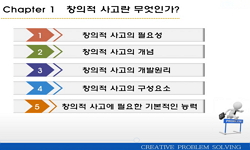School education has not been concerned with what students would learn and experience in class, so much so that students, the subject of the education, have been alienated from the lesson scene. One method for solving this problem is called the Studen...
http://chineseinput.net/에서 pinyin(병음)방식으로 중국어를 변환할 수 있습니다.
변환된 중국어를 복사하여 사용하시면 됩니다.
- 中文 을 입력하시려면 zhongwen을 입력하시고 space를누르시면됩니다.
- 北京 을 입력하시려면 beijing을 입력하시고 space를 누르시면 됩니다.
창조성 신장을 위한 학생 참여형 수업의 교실 적용 방안에 대한 연구 = A Study on the Application of Classroom for “Student-Participatory Class”in the Development of Creative Ability
한글로보기https://www.riss.kr/link?id=A106268005
- 저자
- 발행기관
- 학술지명
- 권호사항
-
발행연도
2018
-
작성언어
-
- 주제어
-
KDC
300
-
자료형태
학술저널
-
수록면
69-103(35쪽)
- 제공처
- 소장기관
-
0
상세조회 -
0
다운로드
부가정보
다국어 초록 (Multilingual Abstract)
School education has not been concerned with what students would learn and experience in class, so much so that students, the subject of the education, have been alienated from the lesson scene. One method for solving this problem is called the Student-participatory class and was published as a slogan through Free Semester in middle school and the 2015 Revised National Curriculum. Therefore, present middle school teachers are directly being asked to teach Student-participatory class. Current political understanding of Student-participatory class is more or less insufficient and limited to drawing students' participation, especially engagement. However, teachers in school fields are considered to have more extensive understanding of Student-participatory class and to be able to have a practical effect on students' engagement. Currently, middle school teachers are directly required to do 'Student-participatory class.' However, it is not easy to apply at the 'Student-participatory class’ current educational scene. Students and teachers need to be prepared. Education emphasizes education that will help students predict and prepare for the future of their careers. In other words, for education for the future, the focus should not be on looking at a tree, but on fostering a creative human being who can also see the forest together. To this end, we need to find ways to apply Student-participatory class to enhance creative ability in the middle school curriculum and apply them gradually on the site. There has been an atmosphere around the world, including those of OECD countries since the 21st century, emphasizing core competences that actively deal with the future society rather than learning and memorizing knowledge. Schools that prepare students for the future should help foster creative ability to enhance their core competencies by reflecting these age trends. However, these core competences cannot be nurtured in a way that unilaterally conveys existing knowledge. Therefore, students need to take the lead in learning projects, experiments, and practices that students explore themselves, gather together to produce results, self-directed learning that allows students to find answers on their own, and discussion classes that allow them to communicate with each other. It is important to spread Student-participatory class as a form of classes that are more suitable for developing their competencies by achieving different educational goals. In addition, teachers should play a role of volunteers in getting students to lead the class away from the role of communicator of existing curriculum knowledge. Students will be able to be more self-reliant and proactive when teachers properly play a role of facilitator in creating a learning environment and guiding and promoting the learning process rather than going to the front of the class.
동일학술지(권/호) 다른 논문
-
제4차 산업혁명시대 도래에 따른 창의지성 진로교육의 방향 및 미래 인재육성 방안 -화성시 학생진로교육 지원사업 성과를 중심으로-
- 창조교육학회
- 김미령 ( Kim Mi-ryung )
- 2018
-
안전 동요를 활용한 창의적 음악활동이 유아의 안전의식, 안전문제해결 사고능력, 음악적 창의성에 미치는 영향
- 창조교육학회
- 전미정 ( Jeon Mi-jeong )
- 2018
-
- 창조교육학회
- 이용길 ( Lee Yong-gil )
- 2018
-
- 창조교육학회
- 김정아 ( Kim Jeong-a )
- 2018




 KISS
KISS







